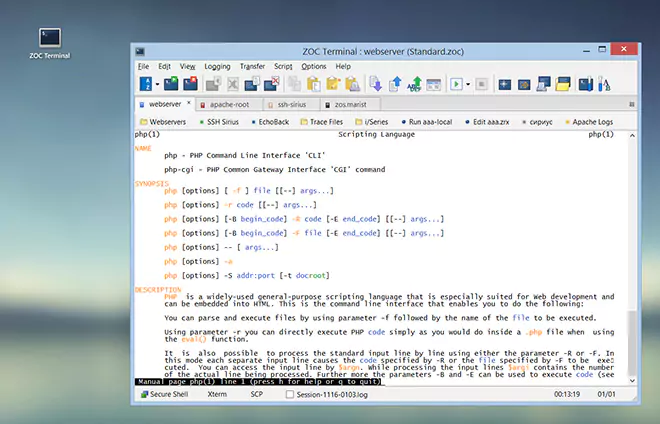Serial/Direct and Serial/Modem → Serial/Modem and Serial/Direct Options
To adjust options for serial connections, navigate to the Connection Type section of the Session Profile. These changes will apply to all connections using that session profile.
If you want to change the options for a single connection, click the Configure button in the Quick Connect window. For connections made through the Host Directory, use the the Configure button found in the Host tab of your host directory entry.
The following options are available when configuring serial connections:
| Com-Port | |
Enter the name of the communications port in this entry field. This is
usually a string like COM1 under Windows (note that there is no space
between COM and 1) or /dev/cu.pl2303serial under macOS. To access com
ports above COM8 on Windows NT or higher use \\.\COMxx.
To use remote COM-ports in a Windows Network, a modem sharing tool (e.g. Stomper)
is required.
| |
| Serial Options | |
In this section you define how data is transferred between your computer and the modem (which is not necessarily the same way the modem uses to transfer data across the telephone line). You have to select a speed (bits per second), the number of data bits, a parity mode (none, even, odd, mark or space) and the number of stop bits. What you use depends mostly on your host.
These settings are often given (e.g. in instructions of how to call a
host) in an abbreviated version, like 38400-8N1 (38400 bits per second,
8 data bits, no parity, one stop bit).
| |
| RTS/CTS handshake | |
If enabled, ZOC uses RTS/CTS hardware handshake for communication with your modem. RTS/CTS is used to control the flow of data between the computer and the modem and provides a way for both to prevent the other from sending data. This is essential for file transfers when the speed of the modem to modem connection is different from the modem to computer connection (which is true for MNP5 of V.42 modems). It is also essential in multitasking environments where the processor might have other things to do when data arrives.
Thus, it is highly recommended to have this option enabled. However,
the modem or attached device needs to support it as well, so check your modem
manual for the proper modem command to "enable bi-directional RTS/CTS hardware flow control"
for use in the modem init string (see Modem Options).
| |
| DSR handshake | |
This DSR/DTR handshake is somewhat similar to RTS/CTS. However, it does not control the data flow, but the general availability of the modem and computer (i.e. if these are turned on).
If enabled, ZOC monitors the DSR signal for communication with the modem.
This option should only be enabled if your modem and your cable properly
provide the DSR signal.
| |
| XON/XOFF | |
If enabled, ZOC uses the Xon/Xoff software handshake for communication (which
is yet another method to control the data stream). It uses special characters
to hold/release the sender. This method is inferior to RTS/CTS handshaking
and should only be used if necessary.
| |
| Valid CD signal | |
If your modem supports the Carrier Detect (CD) signal (most modems will do this if you add AT&C1 to the modem init string in the Modem Options), you should enable this option (which is highly recommended).
ZOC uses the CD signal to control the connection timer and other functions
which depend on if a connection is active or not.
| |
| Break signal duration | |
The duration that is used for sending a break signal (some hosts use
this to break an operation) when pressing Ctrl+End. It is given in
milliseconds and typically ranges from 250 to 400 ms.
| |
| AT-Commands | |
The Serial/Modem method lets you create and select multiple profiles
with AT commands to control modem functions like dial, hangup etc.
You can select an existing profile, change the
AT commands or leave the field empty to use
ZOC's defaults.
| |
| Release port if window is minimized | |
Additionally you can set an option to release the COM port when the ZOC window is minimized. This would allow you to access the COM port from another software while the ZOC windows is minimized. Please note "CD Signal is Valid" option must be activated and the port will only be released if there is no active modem connection. | |
← Back to Serial/Direct and Serial/Modem

